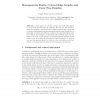Free Online Productivity Tools
i2Speak
i2Symbol
i2OCR
iTex2Img
iWeb2Print
iWeb2Shot
i2Type
iPdf2Split
iPdf2Merge
i2Bopomofo
i2Arabic
i2Style
i2Image
i2PDF
iLatex2Rtf
Sci2ools
ICITS
2011
2011
Homogeneous Faults, Colored Edge Graphs, and Cover Free Families
In this paper, we use the concept of colored edge graphs to model homogeneous faults in networks. We then use this model to study the minimum connectivity (and design) requirements of networks for being robust against homogeneous faults within certain thresholds. In particular, necessary and sufficient conditions for most interesting cases are obtained. For example, we will study the following cases: (1) the number of colors (or the number of non-homogeneous network device types) is one more than the homogeneous fault threshold; (2) there is only one homogeneous fault (i.e., only one color could fail); and (3) the number of non-homogeneous network device types is less than five. 1 Background and colored edge graph In network communications, the communication could fail if some nodes or some edges are broken. Though the failure of a modem could be considered the failure of a node, we can model this scenario also as the failure of the communication link (the edge) attached to this modem...
| Added | 29 Aug 2011 |
| Updated | 29 Aug 2011 |
| Type | Journal |
| Year | 2011 |
| Where | ICITS |
| Authors | Yongge Wang, Yvo Desmedt |
Comments (0)

